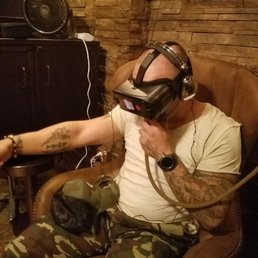A bar in Fishtown is the latest to offer the virtual reality experience.

A Mad Rex patron uses a VR
By Sean Woodruff
Caz Czworkowski is aboard a space station, looking at the Earth from above.
Click
Suddenly, he is on a rollercoaster, doing loops that seem to defy gravity.
Click
Now he is shooting zombies, running through a forest for his life.
Czworkowski escapes these worlds by taking off his virtual reality (VR) headset—he experienced all of that without ever leaving his living room.
As far-fetched as it may sound, modern VR has become incredibly life-like, and millions of people like Czworkowski are spending many hours a week exploring virtual worlds.
Czworkowski is the current head of Philly VR, a group of VR enthusiasts who regularly meet up to discuss the technology, play games, and even do some VR programming.
Despite the fact that VR closes off your senses from the real-world, Czworkowski says that it can be a powerful medium for social interaction.
Instead of solo games, Czworkowski says he prefers games like Rec Room and VR Chat, which act as open social spaces in which you can interact and collaborate with other people online.
“The goal is really just to explore and hang out and have fun together”
Unlike typical online games, where you have little control over the fine-tuned movement of your avatar, in VR games, you can use hand and head tracking to communicate with body language along with your speech.
“You feel like your friends are there with you. It’s the next best thing to actually being there with people,” he says.
Czworkowski isn’t the only one who sees VR as a social technology. In fact, VR is now entering one of the most social spaces of all—the bar.
Mad Rex, a new Fishtown restaurant and bar, has an entire space designated as a “VR Lounge”.
Paul Bruce, general manager at Mad Rex, says that the lounge is a great way for friends and family to hang out in novel environments.
“With multiplayer games you can link up with your friends and family members. So there are a lot of interactive elements,” Bruce says.
Mad Rex has worked hard to make the VR Lounge feel as much like a normal bar as possible. They even serve beer and cocktails in Camelback bags that you can sip through a tube while hooked up to the system.

A man and his VR device
It may seem gimmicky on the surface; but so far, their model has been highly successful.
“At least 90 percent of our customers do the VR,” Bruce says. At $2 per minute per customer, that’s a lot of money for Mad Rex.
When asked whether other restaurants and bars will also adopt VR, Bruce replies, “I think they’re going to have to.”
It’s easy to feel skeptical of Mad Rex’s vision of the future. For many people, sipping beer from a bag and talking to your friends through a microphone probably doesn’t sound like the most fulfilling form of night-life.
But even if VR doesn’t end up in every hipster bar, there are many reasons to believe that VR is about to go mainstream in a big way.
Schools like Mercy Career & Technical High School have already begun using VR in the classroom to give students virtual tours through the human body. Museums like the Franklin Institute are using VR to give visitors a first-hand look at the deep sea. And even restaurants like Honeygrow are using VR to streamline and standardize employee training.
This recent surge in VR adoption is the result of rapid advancements in hardware as well as plummeting costs for the devices.
Although the initial hype surrounding VR began in 2012 with the announcement of the Oculus Rift (the first modern VR headset), prices were high and the early headsets weren’t as flawless as they seemed.
“There used to be a strong disconnect between where your head is and what you’re actually seeing,” Czworkowski says. “This broke the illusion of immersion, and made VR feel gimmicky and fake.”
In some people, it even caused nausea.
But with the newest models, tracking is essentially flawless. “When you move, you see exactly what you expect to see,” Czworkowski says.
Prices are plummeting too. A VR system used to cost up to $2,000. This year, entry-level headsets are expected to sell for as low as $200.
With these dramatic cost cuts, sales are predicted to rise rapidly.
In 2016, only 2.3 million American households owned a VR headset. In 2018, International Data Corporation predicts that over 12 million headsets will be sold.
Czworkowski believes that as the prices continue to drop, even non-gamers and technophobes will fall in love with VR just like he did.
“I wasn’t even interested in gaming until the Rift came out,” he says. But once he got his first glimpse into a VR world, he was in awe.
“It’s just the kind of stuff you dream about.”
